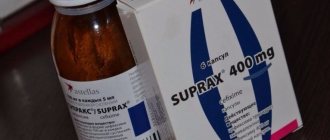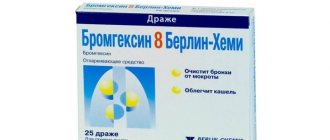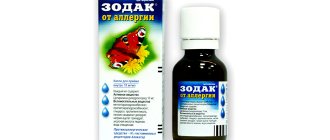pharmachologic effect
The drug belongs to antimicrobial drugs with a wide spectrum of action. The bactericidal effect of ofloxacin is active against most gram-negative bacteria and some gram-positive microorganisms. Anaerobic bacteria are not sensitive to ofloxacin.
After topical application of the drug, after 4 hours, the concentration of ofloxacin reaches the level necessary to suppress the growth of 90% of infectious pathogens.
Dancil 0.3% drops ear, eye dropper bottle 5 ml
A country
India
Country of manufacture may vary depending on the batch of goods. Please check with the operator for detailed information when confirming your order.
Active substance
Ofloxacin
pharmachologic effect
Antimicrobial agent of the fluoroquinolone group with a broad spectrum of action. The bactericidal effect of ofloxacin is associated with the blockade of the DNA gyrase enzyme in bacterial cells. Highly active against most gram-negative bacteria: Escherichia coli, Salmonella spp., Shigella spp., Proteus spp., Morganella morganii, Klebsiella spp. (including Klebsiella pneumoniae), Enterobacter spp., Serratia spp., Citrobacter spp., Yersinia spp., Providencia spp., Haemophilus influenzae, Neisseria gonorrhoeae, Neisseria meningitidis, Mycoplasma spp., Legionella pneumophila, Acinetobacter spp., as well as Chlamydia spp. Active against some gram-positive microorganisms (including Staphylococcus spp., Streptococcus spp., especially beta-hemolytic streptococci). Enterococcus faecalis, Streptococcus pneumoniae, Pseudomonas spp. are moderately sensitive to ofloxacin. Anaerobic bacteria (except Bacteroides ureolyticus) are not sensitive to ofloxacin. Resistant to β-lactamases.
Indications for use
Infectious and inflammatory diseases caused by microorganisms sensitive to ofloxacin, including: diseases of the lower respiratory tract, ear, throat, nose, skin, soft tissues, bones, joints, infectious and inflammatory diseases of the abdominal organs (with the exception of bacterial enteritis ) and pelvis, kidney and urinary tract infections, prostatitis, gonorrhea.
Mode of application
Individual. The daily dose is 200-800 mg, the frequency of use is 2 times a day. For patients with impaired renal function (creatinine clearance 20-50 ml/min), the first dose is 200 mg, then 100 mg every 24 hours. For creatinine clearance less than 20 ml/min, the first dose is 200 mg, then 100 mg every 48 hours. Contraindicated for use during pregnancy and lactation. Experimental studies have not revealed any negative effects on fertility in rats. Contraindicated in children and adolescents under 18 years of age.
Interaction
When used simultaneously with antacids containing calcium, magnesium or aluminum, with sucralfate, with drugs containing di- and trivalent cations such as iron, or with multivitamins containing zinc, the absorption of quinolones may be impaired, leading to a decrease in their concentration in the body. These drugs should not be used within 2 hours before or within 2 hours after taking ofloxacin. With the simultaneous use of ofloxacin and NSAIDs, the risk of developing a stimulating effect on the central nervous system and seizures increases. When used simultaneously with theophylline, it is possible to increase its concentration in the blood plasma (including at steady state), and increase T1/2. This increases the risk of developing adverse reactions associated with theophylline. With simultaneous use of ofloxacin with beta-lactam antibiotics, aminoglycosides and metronidazole, additive interactions were observed.
Side effect
From the digestive system: nausea, vomiting, diarrhea, abdominal pain and cramps, loss of appetite, dry mouth, flatulence, gastrointestinal dysfunction, constipation; rarely - liver dysfunction, liver necrosis, jaundice, hepatitis, intestinal perforation, pseudomembranous colitis, bleeding from the gastrointestinal tract, disorders of the oral mucosa, heartburn, increased activity of liver enzymes, including GGT and LDH, increased bilirubin levels in the blood serum. From the nervous system: insomnia, dizziness, fatigue, drowsiness, nervousness; rarely - convulsions, anxiety, cognitive changes, depression, pathological dreams, euphoria, hallucinations, paresthesia, syncope, tremor, confusion, nystagmus, suicidal thoughts or attempts, disorientation, psychotic reactions, paranoia, phobia, agitation, aggressiveness, emotional lability, peripheral neuropathy, ataxia, coordination disorders, exacerbation of extrapyramidal disorders, speech impairment. Allergic reactions: skin rash, itching; rarely - angioedema, urticaria, vasculitis, allergic pneumonitis, anaphylactic shock, erythema multiforme, Stevens-Johnson syndrome, erythema nodosum, exfoliative dermatitis, toxic epidermal necrolysis, conjunctivitis. From the reproductive system: itching in the area of the external genitalia in women, vaginitis, vaginal discharge; rarely - burning, irritation, pain and rash in the genital area in women, dysmenorrhea, menorrhagia, metrorrhagia, vaginal candidiasis. From the cardiovascular system: rarely - cardiac arrest, edema, arterial hypertension, arterial hypotension, palpitation, vasodilation, cerebral thrombosis, pulmonary edema, tachycardia. From the urinary system: rarely - dysuria, increased frequency of urination, urinary retention, anuria, polyuria, kidney stone formation, renal failure, nephritis, hematuria, albuminuria, candiduria. From the musculoskeletal system: rarely - arthralgia, myalgia, tendinitis, muscle weakness, exacerbation of myasthenia gravis. Metabolic: rarely - thirst, weight loss, hyper- or hypoglycemia (especially in patients with diabetes mellitus receiving insulin or oral hypoglycemic agents), acidosis, increase in serum TG, cholesterol, potassium. From the respiratory system: rarely - cough, nasal discharge, respiratory arrest, dyspnea, bronchospasm, stridor. From the senses: rarely - hearing impairment, tinnitus, diplopia, nystagmus, impaired clarity of visual perception, impaired taste, smell, photophobia. Dermatological reactions: rarely - photosensitivity, hyperpigmentation, vesiculobullous rashes. From the hematopoietic system: rarely - anemia, bleeding, pancytopenia, agranulocytosis, leukopenia, reversible inhibition of bone marrow hematopoiesis, thrombocytopenia, thrombocytopenic purpura, petechiae, ecchymosis, increased prothrombin time. Other: chest pain, pharyngitis, fever, body pain; rarely - asthenia, chills, general malaise, nosebleeds, increased sweating.
Contraindications
Pregnancy, lactation, childhood and adolescence under 18 years of age, hypersensitivity to ofloxacin or other quinolone derivatives.
special instructions
Use with caution in patients with impaired renal and hepatic function. During treatment, it is necessary to monitor blood glucose levels. With long-term therapy, it is necessary to periodically monitor the functions of the kidneys, liver, and peripheral blood picture. When using ofloxacin, the body should be sufficiently hydrated and the patient should not be exposed to ultraviolet radiation. Experimental studies have not revealed any mutagenic potential. Long-term studies to determine the carcinogenicity of ofloxacin have not been conducted. In studies in juvenile animals of several species, ofloxacin caused arthropathy and osteochondrosis. Safety and effectiveness in children and adolescents under 18 years of age have not been established. Effect on the ability to drive vehicles and operate machinery Use with caution in patients whose activities require high concentration and speed of psychomotor reactions.
Dispensing conditions in pharmacies
On prescription
Indications for use
The drug is prescribed for diseases of the anterior segment of the eye and ocular adnexa caused by infections with microorganisms sensitive to ofloxacin. The drug is also used as a prophylaxis for infectious diseases in ophthalmic surgery.
Dancil is used for the following infectious diseases of the ear:
- Acute otitis media when installing a tympanostomy tube;
- Chronic purulent otitis media;
- Otitis externa.
Analogue drugs
Are there analogues of the drug Dancil? Drops in this category can be replaced with other agents belonging to the antimicrobial and anti-inflammatory group. According to their pharmacological action, these include:
- Zoflox;
- Glaufos;
- Dioxidine;
- Taritsin;
- Otipax;
- Otofa;
- Oflocid;
- Ofloxin;
- Oflomak;
- Ofloxacin Teva;
- Oflolxabol;
- Oflox;
- Ofloxacin DS;
- Oflo.
Dosage regimen and method of administration
For infectious eye diseases:
- In the treatment of bacterial corneal ulcers for children from 1 year of age and adults, it is prescribed in a dosage of 1-2 drops in the eye every half hour while awake, after falling asleep it is necessary to instill it every 4-6 hours. Such therapy is carried out over 2 days. Then you should drop 1-2 drops into the eye every hour while awake for the next 4-6 days. Next, 1-2 drops are instilled 4 times a day for the next 3 days until the desired effect is obtained.
- When preventing infections in ophthalmic surgery after eye trauma and surgical procedures, in the treatment of dacryocystitis, meibomitis, keratitis, keratoconjunctivitis, blepharitis and conjunctivitis, eye drops are prescribed only while awake. For children under 1 year of age and adults, it is recommended to take 1-2 drops into the affected eye every 2-4 hours for the first 2 days, then 4 times a day, 1-2 drops for the next 5 days.
For infectious diseases of the ear, the drug is prescribed to adults and children over 15 years of age:
- To treat otitis externa, it is necessary to instill 10 drops into the affected ear once a day for 7 days.
- When treating acute otitis media with a tympanostomy tube, it is necessary to instill 5 drops into the sore ear 2 times a day for 10 days.
- When treating chronic purulent otitis media in case of perforation of the eardrum, 10 drops should be instilled into the sore ear 2 times a day for 14 days.
Using a cold solution as ear drops may cause dizziness. To avoid this, it is necessary to warm the bottle of the drug in your hand for a couple of minutes before use. Ear drops are instilled with the patient lying on his side. After the procedure, the patient should lie down for another 5 minutes for better penetration of the solution into the external auditory canal.
Release form and composition
The dosage form of Dancil is ear and eye drops: light yellowish, transparent (5 ml in plastic dropper bottles with a screw cap, or in plastic bottles sealed with a dropper stopper; 1 bottle or dropper bottle in a cardboard box).
Composition of 1 ml drops:
- active substance: ofloxacin – 3 mg;
- auxiliary components: benzalkonium chloride – 0.1 mg; sodium chloride – 8 mg; edetate disodium – 1 mg; hypromellose – 2 mg; sodium hydroxide - in sufficient quantity; hydrochloric acid - in sufficient quantity; water for injection – up to 1 ml.
Side effects
When instilling Dancil into the eyes, discomfort and burning in the eyes, a feeling of dry eye, lacrimation, itching, photophobia, pain in the eye, swelling of the periorbital area or face, blurred vision, sensation of a foreign body in the eye, keratitis, contact conjunctivitis, redness may occur. conjunctiva.
In rare cases, headache, nausea, dizziness, stupor, hemorrhagic conjunctivitis with swelling of the eyelid may occur.
When using the drug in the form of ear drops, the following local reactions may occur: redness of the eardrum, mild pain, allergic reaction, transient hearing loss, ringing in the ears.
Contraindications
Dancil eye drops are prohibited:
- women in any trimester of pregnancy and during the lactation period;
- children under 16 years of age for treatment of ENT organs;
- for children under one year of age for use in ophthalmology;
- epilepsy;
- traumatic conditions of the head;
- dysfunction of the central nervous system;
- with sensitivity to ofloxacin.
The drug has not been shown to be effective against non-bacterial infections of the ear, nose and eyes.
Carefully:
- for diabetes mellitus (Dancil increases blood glucose levels);
- in summer (exposure to the sun is prohibited).
When performing complex technical work, you must refrain from using the drug. May cause visual disturbances.
During pregnancy, taking the drug is strictly prohibited
When removal of lower eyelid hernia is indicated, find out from the article.
special instructions
Long-term use of ofloxacin, as well as any other antimicrobial agent, leads to an increase in flora that is insensitive to the antibiotic. Therefore, if the treatment does not give the required effect within the standard period of therapy or the condition worsens, then the medicine should be discontinued and another treatment should be started.
It is not recommended to wear soft contact lenses during treatment. Hard contact lenses should be removed before instillation and put back on only 20 minutes after the procedure.
The drug is not recommended for instillation into the anterior chamber of the eye and subconjunctivally.
It is advisable to wear sunglasses during treatment, as photophobia may develop, and to avoid prolonged exposure to bright sunlight.
Summing up
Summarizing all of the above, let's make a small conclusion:
- Dancil ear drops are an effective remedy in the fight against otitis caused by microorganisms sensitive to the drug. In addition, the drug is widely used in ophthalmology.
- The medicine has an antifungal and anti-inflammatory effect on the source of infection.
- It is recommended to use the drug only as prescribed by a doctor. Self-medication is unacceptable, otherwise it may lead to a worsening of the current condition of the disease. Therefore, it is extremely important to consult a doctor, receive individual recommendations and strictly follow the prescribed treatment regimen.
Take care of yourself and be healthy!
Price
The drip solution has different prices depending on the area of its sale and the pharmacy chain.
| Province/region | Dosage form/volume | Price |
| Moscow, Moscow region | Drops, 0.3%, 5 ml | 112-199 rub. |
| Saint Petersburg | Drops, 0.3%, 5 ml | 138-234 rub. |
| St. Petersburg (suburbs) | Drops, 0.3%, 5 ml | 124-205 rub. |
| Novgorod region | Drops, 0.3%, 5 ml | 133-214 rub. |
| Leningrad region | Drops, 0.3%, 5 ml | 142-187 rub. |
Before using Dancil, you should carefully read the instructions for using ear drops. Additionally, it is recommended to consult with a pharmacist or specialist, and also study patient reviews. You can find out the cost and purchase the drug at any commercial or government pharmacy located near your place of residence.
Reviews about Dancil
The use of Dancil is indicated for various eye and ear diseases of an infectious nature. Often in these diseases there is a mixed infection, so preference is given to broad-spectrum drugs. This drug has bactericidal activity, penetrates well into the cornea and middle ear tissue, and is well tolerated. Ofloxacin-based drops are recommended as the drug of choice for the prevention of postoperative endophthalmitis; they are used to prevent complications from eye injuries and burns. They are also effective for chlamydial conjunctivitis. For the treatment process to be effective, the doctor must prescribe the drug, taking into account the severity of the disease and the severity of the process.
- “...They prescribed Dancil in the ear. I can say that they help quickly and are not expensive.”
- “... My daughter had otitis media with perforation. The medicine proved to be very effective. The treatment lasted 2 weeks and one bottle was enough for us.”
- “...Highly effective for otitis media and an affordable price.”
- “... Prescribed for sinusitis and tubo-otitis. There was pain in my ear and it was so full that I couldn’t hear anything. After the first time of use, congestion disappeared and hearing was restored.”
- “... The child regularly developed otitis media. They treated me with Otipax, but it did not help. The doctor prescribed Dancil. We were treated and forgot about inflammation.”
- “... I had a stye, and the doctor prescribed these drops, but I was able to use them, so terrible lacrimation began and I could not look at the light at all.”
- “... Prescribed for chlamydial conjunctivitis. I was cured, although I used it for a long time—three weeks.”
Pharmacodynamics and pharmacokinetics
Pharmacodynamics
The active ingredient is a synthetic fluorinated quinolone. It has an antibacterial effect against gram-negative and gram-positive (to a lesser extent) microorganisms. It is used in ophthalmology and ENT practice for the treatment of diseases caused by chlamydia, Proteus mirabilis, Enterobacter cloacae, Pseudomonas aeruginosa, Streptococcus pneumoniae, Staphylococcus aureus and Staphylococcus epidermidis. The mechanism of action is explained by the inhibition of DNA hydrase of microorganisms, which ensures the stability of their DNA (destabilization leads to death). The active substance is not destroyed by beta-lactamases, aminoglycosides, adenylases and phosphorylases.
Has a bactericidal effect.
Pharmacokinetics
The concentration of the active substance in the tear fluid exceeds the minimum required to suppress the growth of eye pathogens. Instillation into the ear with an intact eardrum is accompanied by slight absorption, which increases when it is perforated. With perforation, the peak blood concentration is 10 ng/ml. It was noted that the maximum concentration in the blood after 10 days of local use is 1000 times less than when using ofloxacin tablets.









